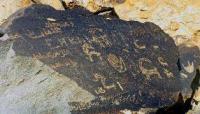You are here
Rock Art Sites in Turkmenistan.

Photos tour on petroglyphs Turkmenistan.
“The universe contains many planets which make it what it is – a unified system. In addition, our bodies contain many organs, and each part is congruent to a planet in our solar system. The universe we see out our eyes is a mirror of what is within us. This is what God meant by making man in his image. We are all made as a reflection of God and that reflection of him is within us. Furthermore, not only are all religions connected to the same Truth, or Cosmic Heart, but this concept is also mirrored in the pantheons of ancient religions, where each of the many gods simply represented one set of characteristics of the ONE. And in all cases, these many gods symbolized the planets, therefore mimicking the different parts of the universe and the ONE God’s many mirrors (He Who is All). The structure behind all polytheistic religions of the past and present is one and the same. They are all built on the same foundation as Nature”
Suzy Kassem.
Photos petroglyphs of Turkmenistan.
Turkmenistan rock art sites were identified in two areas – in the north of the country, by the southern edge of the Ustryurt Plateau, in the Near Sary-Kamish Delta, and in the south-west of the country in the Chandyr River (Sumbar River tributary) valley, in the southwestern spurs of the Kopet-Dag Range.
Petroglyphs in Northern Turkmenistan (Ustyurt Plateau, Butentau Upland) Geographic description of the area Southern Ustyurt’s steep precipices shape the national borders of Turkmenistan and Kazakhstan. Those at Ustyurt tower over neighboring plains as precipitous walls about 300m high.
To the east of Ustyurt, a series of low-lying plateaus and desert mountains (Djantak) is also known as the Zauzboy mountain area. Near the Sary-Kamish Delta is a flat sand and loamy plain that stretches from the lower reaches of the Amu Darya River to Lake Sary-Kamish.
The Near SaryKamish Delta gradually merges with the Near Aral Delta of the Amu Darya River in the north-east. In the south, it borders a high sand plain (Zaunguz Karakums), while in the north it is confined by the Ustyurt precipices. Its total range is 160km long and 120km wide.
On the territory of the delta adjacent to Lake Sary-Kamish, a number of plateau-like residual mountain uplands consist of Tertiary marine deposits. Their top layer is made of bedded formations of limestone, gypsum and Miocene marl.
These uplands have a common geological structure with the Ustyurt Plateau and used to be one with the plateau in the pre-Khvalynskiy period. The flatlands of the Near Sary-Kamish Delta, adjacent to the uplands, are cut across by ancient riverbeds.
Most of them such as Daudan, Daryalyk are well defined in the relief and can be followed for tens of kilometers. The largest remaining uplands with steep slopes are Butentau, Tarym-Kaya, Kanga-Gyr, and TuzGyr.
Artificial caves with a multitude of petroglyphs are located in two of them – Butentay and Tarym-Kaya– and the southern precipices at Ustyurt in joint faces of aleurite-limestone Neogene rock, 1.3-1.5m thick, at a height of 15 - 20m from the top edge of cliff debris covering the uplands.
Research Status Northern Turkmenistan rock art sites were discovered in the 1950s by the leader of the Khorezm Archeological and Ethnographic Expedition of the USSR Academy of Sciences, S.-P. Tolstov. In 1951, he examined a cave at Butentau and dated cave dwellings to the Early Middle Ages from ceramic remains.
In 1956, members of the Karakalpak Branch of the Academy of Sciences of the Uzbek SSR, Gudkova A.V. and Vizhanov E., in cooperation with experienced mountain climbers, descended into several caves and described them.
In one of them, they found a vessel from the XIIth - XIIIth centuries and a tamga (“stamp or seal”) on the wall. Cave dwellings in the Ustyurt, Butentau and Tarym-Kaya precipices were studied from 1974 to 1994 by various groups of speleologists led by Chernishev I.V., who studied over 200 caves and discovered about 600 obstructed cave entrances (Orazov 2007).
Authority:
Edjegul Muradova.
Photos by
Alexander Petrov.







